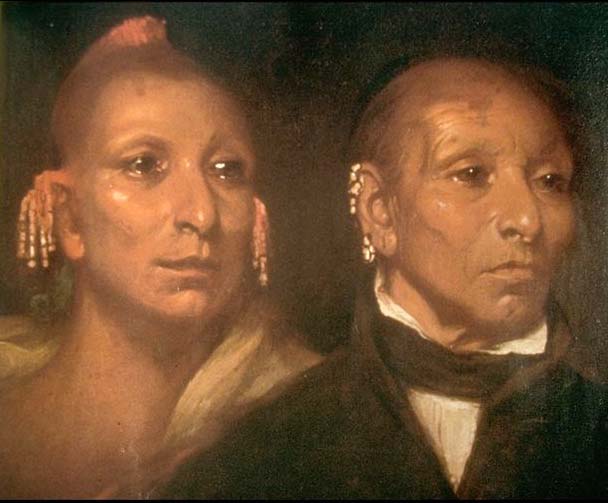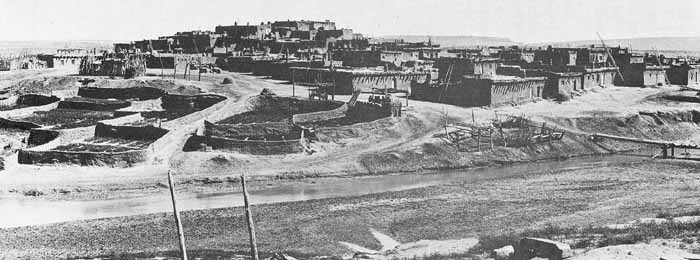|
|
Canku Ota |
|
|
(Many Paths) |
||
|
An Online Newsletter Celebrating Native America |
||
|
May 18, 2002 - Issue 61 |
||
|
|
||
|
This Date In |
||
|
North American Indian History |
||
|
from On This Date in North American Indian History at http://americanindian.net |
||
| May 18, 1661: | Captain John Odber is order by the Maryland General Assembly to take fifty men and go to the "Susquesahannough Forte." According to a treaty signed on May 16th, Maryland is required to help protect the Susquehannocks from raids by the Seneca. Odber’s force is to fulfill that part of the treaty. |
|
|
|
| May 19, 1795: | A treaty is signed between the Chippewa and the Canadian government. Second Lieutenant J. Givins represents the crown and several Chippewa Chiefs are present. It is signed at "York, in the Province of Upper Canada" (Penetanguishene, Ontario). |
|
|
|
| May 20, 1702: | Franciscans have established the Mission of Santa Fe de Toluca at one of the largest Timucua villages in northern Florida. Apalachicola Indians fight a battle with Spanish and Mission Indians. Both side lose a considerable number of fighters before the Apalachicolas finally gain the upper hand. |
|
|
|
 Black Hawk and His Son Whirling Thunder Painter: John Wesley Jarvis, 1833 |
|
| May 21, 1832: | As a part of Black Hawk’s War, a group of approximately fifty Potawatomis attack a settlement on Indian Creek near modern Ottawa, Illinois. Fifteen settlers are killed in the fighting. This is often called the "Indian Creek Massacre." This is also reported to have happened on May 20th. |
|
|
|
| May 22, 1863: | As a part of the "Owens Valley War" in California, Paiute Chief Captain George arrives at Camp Independence. He tells the soldiers the Paiutes want peace. This effectively ends the war. |
|
|
|
| May 23, 1838: | Under the provisions of the New Echota Treaty of December 29, 1835, this the deadline for Cherokees to emigrate to the Indian Territory (present day Oklahoma). Any Cherokees still east of the Mississippi River, after today, are forced to leave. Only an estimated 2,000 Cherokees have emigrated to the Indian Territory by today's date, according to government estimates. General Winfield Scott is charged with removing the recalcitrant Cherokees. Many are forced from their homes at bayonet point. The illegal treaty is publicly proclaimed by President Jackson, two years ago, on this date. |
|
|
|
 This view of the pueblo of Zuni, New Mexico in the late 1800's gives a fairly accurate idea of the appearance of Hawiku, on its low hill, when the Coronado army attacked in July, 1540. |
|
| May 24, 1539: |
Mexican Viceroy Don Antonio de Mendoza has decided to send an expedition to search for wealthy cities north of Mexico. On March 7, 1539, Friar Marcos de Niza started the expedition from Culiacan. Accordiong to Niza’s journal, he finally sees Cibola, although he never sets foot in the pueblo. His report will lead to future expeditions looking for the "Seven Cities of Gold." |
|
|
|
| May 25, 1776: | The United States Congress resolves that it would be "highly expedient" if they can engage Indians to fight on their side of the Revolutionary War. |
|
|
|
| May 26, 1540: |
The "Lady of Cofitachequi" has been taken with the de Soto expedition, against her will. With a large quantity of the pearls that de Soto's men took from her village, she escapes. |
|
|
|
| May 27, 1847: | The Oregon Country publication "The Spectator" has an article by its editor, George L. Curry. He blames much of the problems with the local Indians on their use of alcohol. He asks for better enforcement of the laws prohibiting the sale of "intoxicants" to Indians. |
|
|
|
| May 28, 1851: | One in a series of treaties is signed with California Indians at Dent's and Ventine's Crossings. The purpose of the treaty is to reserve lands for the Indians and to protect them from angry Europeans. |
|
|
|
| May 29, 1677: | Pamunkey, Roanoke, Nottaway and Nansemond Tribes of the Powhatan Confederacy sign a treaty with the English in Virginia. |
|
|
|
| May 30, 1650: | An ordinance is passed against the making of counterfeit, or "fake," wampum by the Directors of the Council of the New Netherlands. European manufacturers are producing the fakes, which are being used to pay Indians. |
|
|
|
 Caughnawaga Wampum Belt |
|
| May 31, 1796: | The Treaty of the Seven Tribes of Canada is signed by three Chiefs at New York City. The tribes give up all claims to lands in New York, except six square miles in Saint Regis. They are paid 1233 pounds, six shillings, and eight pence now, and 213 pounds, six shillings, eight pence annually, if five more Chiefs show up and sign the treaty. |
|
|
|
|
For Information on This Date in Canada visit our friends at: |
|
Canadian
Aboriginal News |
|
|
||
|
|
||
| Canku Ota is a free Newsletter celebrating Native America, its traditions and accomplishments . We do not provide subscriber or visitor names to anyone. Some articles presented in Canku Ota may contain copyright material. We have received appropriate permissions for republishing any articles. Material appearing here is distributed without profit or monetary gain to those who have expressed an interest. This is in accordance with Title 17 U.S.C. section 107. | ||
|
Canku Ota is a copyright © 2000, 2001, 2002 of Vicki Lockard and Paul Barry. |
||
|
|
|
|
|
The "Canku Ota - A Newsletter Celebrating Native America" web site and its design is the |
||
|
Copyright © 1999, 2000, 2001, 2002 of Paul C. Barry. |
||
|
All Rights Reserved. |
||
